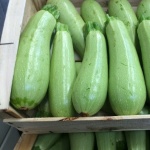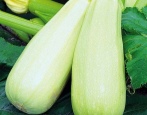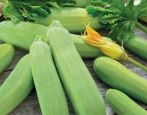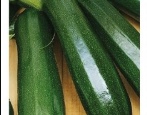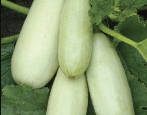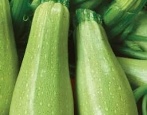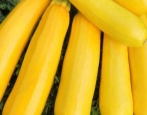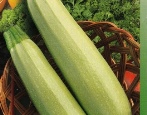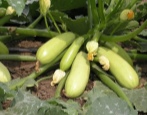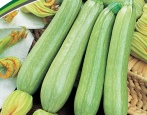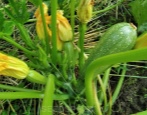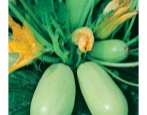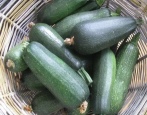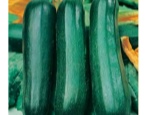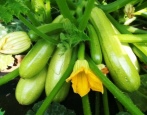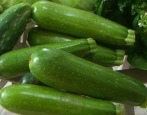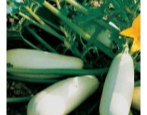
- Year of approval: 1943
- Ripening terms: mid-early
- The period from germination to harvest: 46-57 days
- Description of the plant: strongly branching
- Leaves: pentagonal, slightly dissected, medium size, green, no white spot
- Fruit shape: short cylindrical
- Fruit color: light green
- Color of the pulp: white
- Pulp (consistency): medium density
- Fruit weight, kg: 0,7-1,3
Zucchini Gribovskie 37 is a classic variety that has been delighting gardeners with reliability and excellent delicate taste for more than 70 years.
Description of the variety
The variety was included in the Russian State Register in 1943. Originators: Federal Research Center for Vegetable Growing, agrofirm "Aelita" and agrofirm "Poisk". Gribovskie 37 is a variety, so it is enough to purchase seeds once. For subsequent plantings, you can use your own seeds.
Characteristics of the appearance of plants and fruits
The bush is highly branched, up to 2.5 meters, with medium-sized pentagonal leaves. The color of the leaves is solid green. Petioles - up to 29-32 cm. Fruits are oval, shaped like barrels, 18-20 cm long, about 10 cm in diameter. In technical ripeness, the skin is light green, strong. The pulp is pure white, medium-dense. The seed area is light yellow. Fruit weight from 700 grams to 1 kg 300 g.
Purpose and taste
The taste is good, the flesh of the Gribovskiye 37 zucchini is very tender. The fruits are intended for any home cooking purpose. They are used fresh in salads and appetizers - the pulp of zucchini is dietary and even healing. Suitable for making caviar and any other canned food for the winter, keep their properties frozen.
Ripening terms
The variety is medium early, with a prolonged fruiting period. The first fruits can be removed after 1.5 months. The average time for the first harvest is 46-57 days. It is important to harvest on time. The fruits of the variety grow relatively quickly, the overgrown coarse.
Yield
From 1 sq. m remove an average of 4.2-8.2 kg of fruit. From 1 bush, from 2 to 25 zucchini are obtained, depending on the methods of crop formation.
Growing regions
The variety is universal, persistent and hardy, it is successfully grown in all regions of Russia.
Growing and caring
For 1 sq. m you can plant 2 plants. Usually, Gribovsky zucchini is planted every 70 cm, in row spacing - 70-100 cm.
It is better to cut off the first male flowers - the fruits will be tied faster. The first fruits are also removed very early - this stimulates the formation of new ones. If you need to maximize the yield, then all the fruits are harvested in an immature state, avoiding coarsening. In this case, 10 and 20 kg of fruit can be obtained from the bush. Planting through seedlings can further increase these numbers. Zucchini can bear fruit all summer long.
Sowing with seeds in open ground is performed when the soil has warmed up to + 14 ... 16 ° С. Gribovskiye zucchini are resistant, calmly tolerate a drop in temperature to + 5 ° C, but this culture is thermophilic, and it is better not to expose plants, especially young ones, to stress. When the temperature drops to zero, the plants will die. Therefore, both seeds and seedlings in most regions of the Russian Federation are planted in open ground no earlier than the 2nd half of May.
Zucchini do not like transplants, so it is best to grow seedlings in peat pots or disposable containers.
The seeds are pre-soaked in a stimulant solution (Epin, Zircon). 2 seeds are placed in each well, the weaker plant is then removed. The seeding depth depends on the soil. On light, loose soils - 5-7 cm, on more dense - no more than 3 cm. After the seeds are embedded in the soil, it is watered and mulched. Seedlings will appear in a week.
The soil under the zucchini is regularly loosened and weeded. These activities will not be needed when the leaves are closed.After the leaves have closed, it is useful to remove some of them so that pollinating insects have access to the flowers.
Zucchini love abundant high-quality watering, especially in hot weather. In dry periods, they are watered at least 1 time a day, in the evening. Water for irrigation should be warm.
Zucchini love feeding with organic matter, twice a season you can add a mullein solution: 1 part manure to 10 parts water. Under each bush, 1 liter of solution is poured into the already moistened soil. It is better to combine top dressing with the significant stages of plant development.
During the formation of a pair of true leaves - with an emphasis on nitrogen.
Potassium-phosphoric - during the period of bud formation.
Potassium-phosphoric - during fruiting.
Like any white-fruited zucchini, the variety is quite delicate. Young fruits are stored in the refrigerator for about 2 days, then the pulp loses its turgor. If harvested later, the zucchini can stay in the refrigerator for 2-4 weeks. It is best to harvest the fruits early in the morning, when they are saturated with moisture as much as possible. It is important to collect carefully. Whole fruits are stored much better than those with a damaged or scratched skin.
The only serious drawback of the Gribovskie 37 variety is an active bush that requires a lot of space on the site. Modern gardeners choose bush varieties or compact hybrids. Correct formation partially solves the issue. Climbing zucchini is pinched over 6 leaves, individual gardeners remove the main stem during the period of bud formation. In this case, lateral lashes begin to grow, their length will be 60-70 cm.
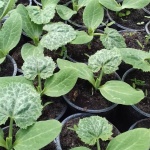
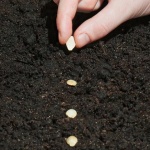
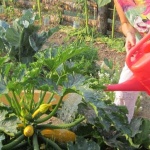
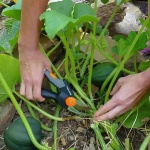
Soil requirements
The best soil is black soil or light nutritious loam. The acidity of the soil is neutral, 5.5-6.5. On sandy soils, zucchini lacks moisture and nutrition, clay is carried out - 20 kg of clay and 3 kg of sawdust per 1 sq. m. Zucchini needs a moisture content of 75-100%, such soils can be rolled into a ball, and it does not crumble in flight. Groundwater should not be close. Good drainage and air permeability of the soil is essential. Peatlands have good structure but are poor in nutrients. They are dug up, introducing 10 kg of turf and 3 kg of compost per 1 sq. m.
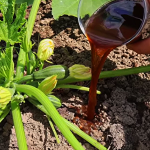
Disease and pest resistance
The variety was bred in 1943 and in terms of disease resistance has become a little outdated. The plant may be slightly affected by bacteriosis and powdery mildew.
It is relatively resistant to fruit rot, but does not belong to the most hardy varieties.
Review overview
The variety is a classic. Despite the age and the abundance of "competitors", gardeners still like it very much. Gribovskie zucchini are less capricious, do not get sick and do not dry out, unlike newfangled hybrids, they show excellent productivity.The fruits are versatile, tasty, with milky or firm pulp - depending on the time of collection. Many people emphasize the importance of timely collection of fruits - in this case, fresh fruits can be removed before frost. There are reviews about the early defeat of the bushes by bacterial diseases, but the authors emphasize that this was in a difficult summer with an alternation of radically different weather: dry heat was replaced by cold and torrential rains.
There are few complaints about the size of the bush, many noted that the plant, on the contrary, is quite compact. The most important advantages of the variety: iron reliability, unpretentiousness, yield, universal white-fruited fruits. Against the background of yellow and green-fruited zucchini, white ones are the most delicate. Gribovskie are great in fried and stewed form, the best caviar and canned vegetables are obtained from the fruits of the variety.
